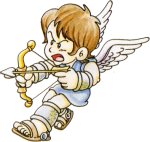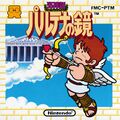Template:Infobox Template:Series disambig Kid Icarus (光神話 パルテナの鏡 Hikari Shinwa: Parutena no Kagami?, Myth of Light: The Mirror of Palutena) is a platform game developed by Nintendo R&D1 and published by Nintendo for the Famicom Disk System in 1986 and the NES in 1987. It was the eleventh best selling Famicom game released in 1986, selling approximately 1,090,000 copies in its lifetime. It is the first game in the Kid Icarus series, the second being Kid Icarus: Of Myths and Monsters.
Kid Icarus is often compared to Metroid (which was released the same year), as it uses the same game engine. It even includes a Metroid-like enemy, known as "Komayto". The game manual theorizes that Komayto may have come from another planet. In volume 204 of Nintendo Power, an article was written about the game describing it as blending together elements from The Legend of Zelda, Super Mario Bros., and Metroid, stating that Pit can "jump like Mario, collect items like Link, and shoot enemies like Samus."
The original Famicom Disk System versions feature save slots, unlike the North American version which uses a password system (known in-game as "Sacred Words"). As with Metroid, the FDS version of Kid Icarus also features higher-quality music and sound effects that take advantage of the system's additional sound channels. (see below). Kid Icarus was produced by Gunpei Yokoi and the music was composed by Hirokazu Tanaka. The game has been re-released twice: on August 10, 2004, for the Game Boy Advance as part of the Famicom Mini Series in Japan only, and on January 23, 2007, on the Wii Virtual Console in Japan. It has since been released in the North American, European, Australian, and South Korean Virtual Console markets as well.
-
Japanese cover
-
European cover
-
Famicom Mini GBA cover
WOW
Regional variations
The controls differ slightly between the Japanese and the North American versions. In the Japanese version, at the Palace in the Sky stage, the player must either hold or tap the A Button repeatedly to make Pit fly, whereas in the North American version, the screen scrolls automatically, thus making Pit fly with the screen automatically as well.
Since the Japanese version was released on the Famicom Disk System, some of the sound effects are different than the U.S. version. Most noticeable are the sounds the Grim Reaper makes (he sounds like he's screeching instead of just "blip blup"), the timer sound when players grab a Harp, the noise Pit makes when he's hit by an enemy (a grunt instead of a squeal), and some extra instruments in the music.
Also, there are alternate endings between the Japanese version and the North American version. In the North American version, after Medusa is defeated, the player sees a short scene where Palutena thanks Pit and offers him a reward, depending on the player's progress, with the credits following afterward. In the Japanese version, however, the player's reward for beating the game is a picture with Pit standing by Palutena, with Japanese text above the two (in English, it says "Thank you, [file name]!"), and no credits at all.



